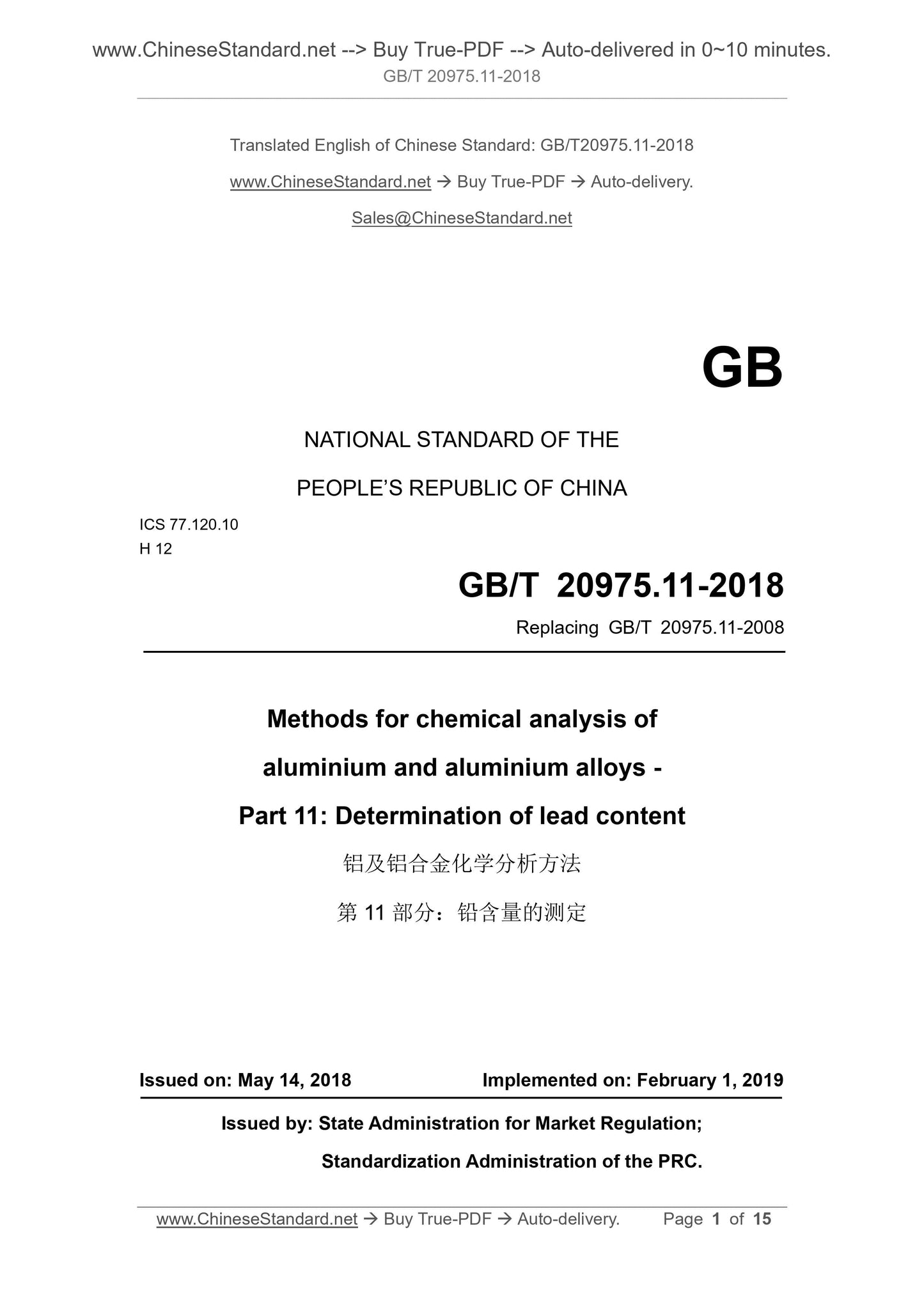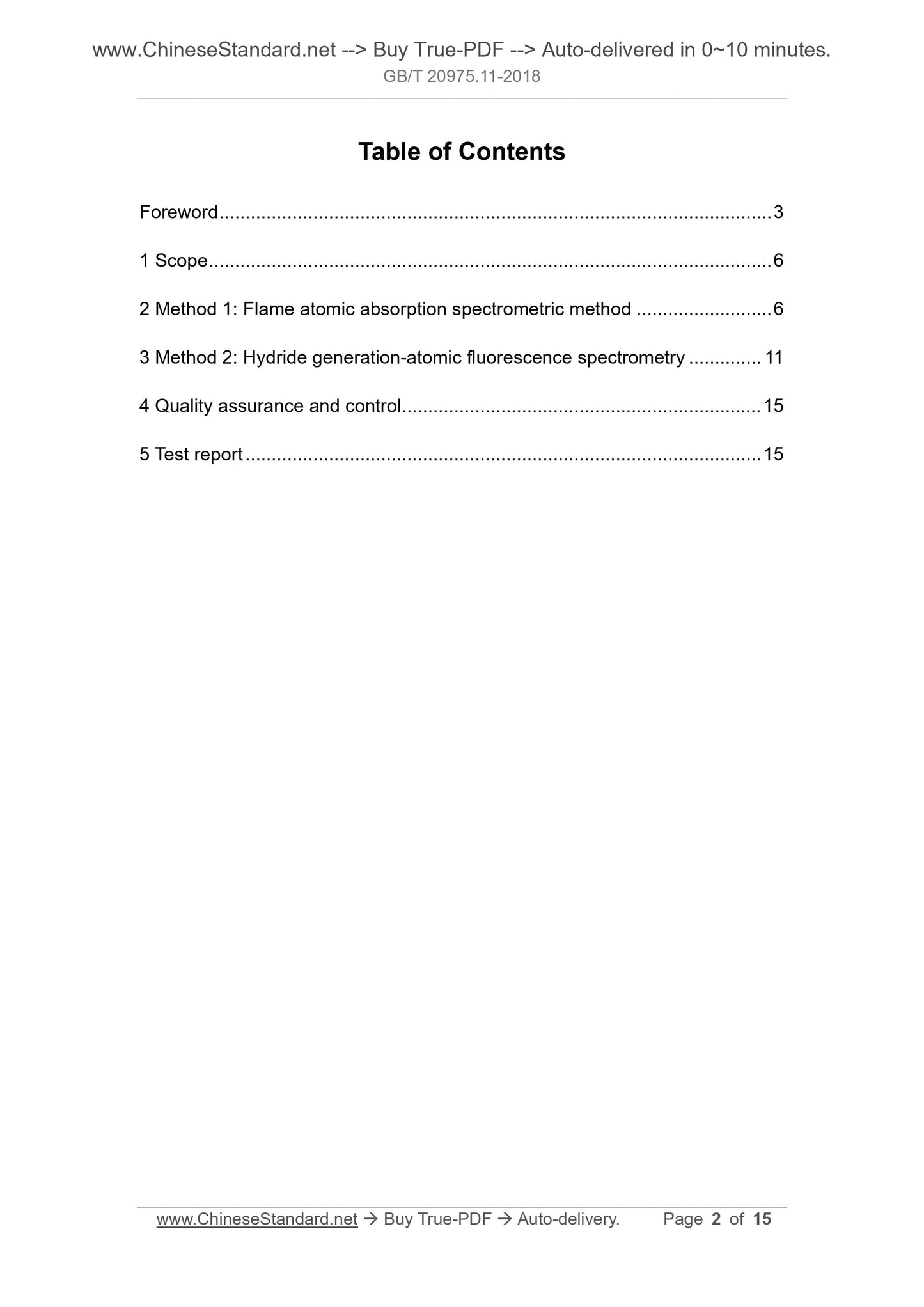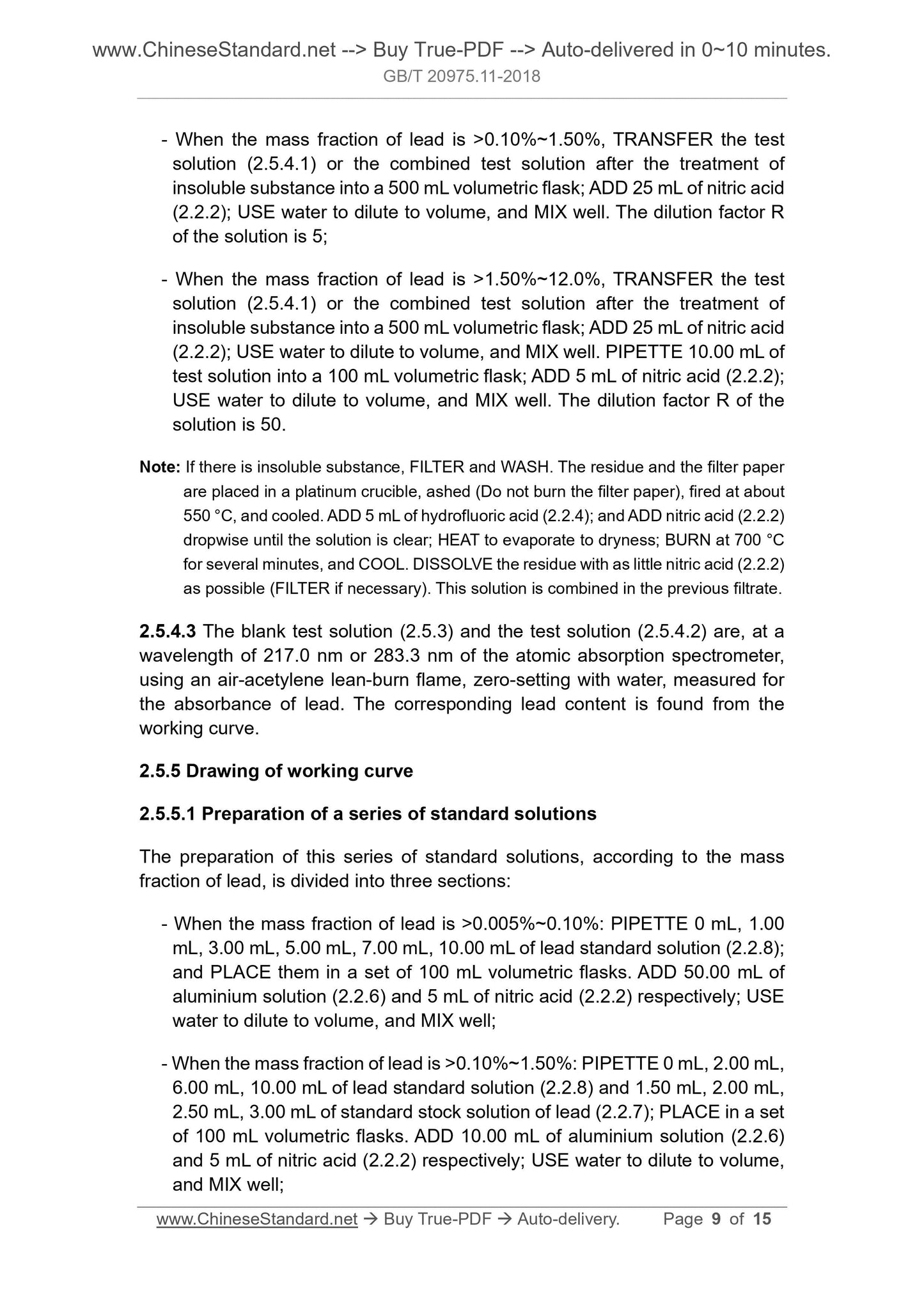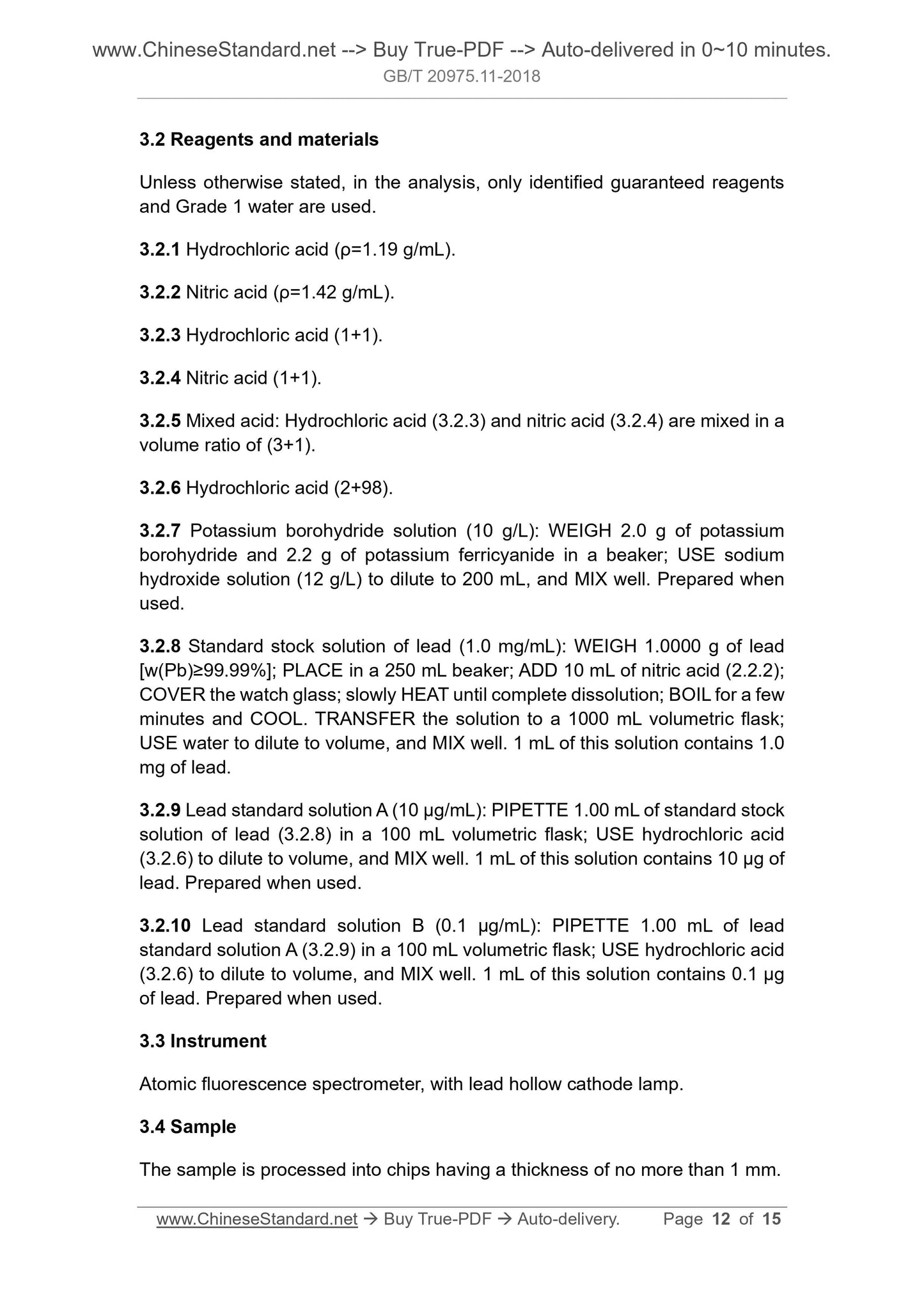1
/
of
6
www.ChineseStandard.us -- Field Test Asia Pte. Ltd.
GB/T 20975.11-2018 English PDF (GB/T20975.11-2018)
GB/T 20975.11-2018 English PDF (GB/T20975.11-2018)
Regular price
$150.00
Regular price
Sale price
$150.00
Unit price
/
per
Shipping calculated at checkout.
Couldn't load pickup availability
GB/T 20975.11-2018: Methods for chemical analysis of aluminium and aluminium alloys - Part 11: Determination of lead content
Delivery: 9 seconds. Download (and Email) true-PDF + Invoice.Get Quotation: Click GB/T 20975.11-2018 (Self-service in 1-minute)
Newer / historical versions: GB/T 20975.11-2018
Preview True-PDF
Scope
This Part of GB/T 20975 specifies the method for determination of lead contentin aluminium and aluminium alloys.
Method 1 of this Part is applicable to the determination of lead content in
aluminium and aluminium alloys. Aluminium in aluminium and aluminium alloys
interferes with the determination of lead. The same amount of aluminium is
added to the working curve to eliminate interference, and other coexisting
elements do not interfere with the determination of lead. The measurement
range of Method 1 is. >0.005%~12.0%. Method 2 of this Part applies to the
determination of lead content in aluminium and aluminium alloys. All coexisting
elements in aluminium and aluminium alloys do not interfere with the
determination of lead. The measurement range of Method 2 is.
0.0001%~0.005%.
2 Method 1. Flame atomic absorption spectrometric
method
2.1 Method principle
The test portion is dissolved with hydrochloric acid-nitric acid mixed acid. At a
wavelength of 217.0 nm or 283.3 nm of an atomic absorption spectrometer, the
absorbance of lead is measured with an air-acetylene lean-burn flame, and the
mass fraction of lead is calculated.
2.2 Reagents and materials
Unless otherwise stated, in the analysis, only identified analytically pure
reagents and Grade 3 water are used.
2.2.1 Aluminium [w(Al)≥99.99%, free of lead].
2.2.2 Nitric acid (ρ=1.42 g/mL).
- When the mass fraction of lead is >0.10%~1.50%, TRANSFER the test
solution (2.5.4.1) or the combined test solution after the treatment of
insoluble substance into a 500 mL volumetric flask; ADD 25 mL of nitric acid
(2.2.2); USE water to dilute to volume, and MIX well. The dilution factor R
of the solution is 5;
- When the mass fraction of lead is >1.50%~12.0%, TRANSFER the test
solution (2.5.4.1) or the combined test solution after the treatment of
insoluble substance into a 500 mL volumetric flask; ADD 25 mL of nitric acid
(2.2.2); USE water to dilute to volume, and MIX well. PIPETTE 10.00 mL of
test solution into a 100 mL volumetric flask; ADD 5 mL of nitric acid (2.2.2);
USE water to dilute to volume, and MIX well. The dilution factor R of the
solution is 50.
Note. If there is insoluble substance, FILTER and WASH. The residue and the filter paper
are placed in a platinum crucible, ashed (Do not burn the filter paper), fired at about
550 °C, and cooled. ADD 5 mL of hydrofluoric acid (2.2.4); and ADD nitric acid (2.2.2)
dropwise until the solution is clear; HEAT to evaporate to dryness; BURN at 700 °C
for several minutes, and COOL. DISSOLVE the residue with as little nitric acid (2.2.2)
as possible (FILTER if necessary). This solution is combined in the previous filtrate.
2.5.4.3 The blank test solution (2.5.3) and the test solution (2.5.4.2) are, at a
wavelength of 217.0 nm or 283.3 nm of the atomic absorption spectrometer,
using an air-acetylene lean-burn flame, zero-setting with water, measured for
the absorbance of lead. The corresponding lead content is found from the
working curve.
2.5.5 Drawing of working curve
2.5.5.1 Preparation of a series of standard solutions
The preparation of this series of standard solutions, according to the mass
fraction of lead, is divided into three sections.
- When the mass fraction of lead is >0.005%~0.10%. PIPETTE 0 mL, 1.00
mL, 3.00 mL, 5.00 mL, 7.00 mL, 10.00 mL of lead standard solution (2.2.8);
and PLACE them in a set of 100 mL volumetric flasks. ADD 50.00 mL of
aluminium solution (2.2.6) and 5 mL of nitric acid (2.2.2) respectively; USE
water to dilute to volume, and MIX well;
- When the mass fraction of lead is >0.10%~1.50%. PIPETTE 0 mL, 2.00 mL,
6.00 mL, 10.00 mL of lead standard solution (2.2.8) and 1.50 mL, 2.00 mL,
2.50 mL, 3.00 mL of standard stock solution of lead (2.2.7); PLACE in a set
of 100 mL volumetric flasks. ADD 10.00 mL of aluminium solution (2.2.6)
and 5 mL of nitric acid (2.2.2) respectively; USE water to dilute to volume,
and MIX well;
3.2 Reagents and materials
Unless otherwise stated, in the analysis, only identified guaranteed reagents
and Grade 1 water are used.
3.2.1 Hydrochloric acid (ρ=1.19 g/mL).
3.2.2 Nitric acid (ρ=1.42 g/mL).
3.2.3 Hydrochloric acid (1+1).
3.2.4 Nitric acid (1+1).
3.2.5 Mixed acid. Hydrochloric acid (3.2.3) and nitric acid (3.2.4) are mixed in a
volume ratio of (3+1).
3.2.6 Hydrochloric acid (2+98).
3.2.7 Potassium borohydride solution (10 g/L). WEIGH 2.0 g of potassium
borohydride and 2.2 g of potassium ferricyanide in a beaker; USE sodium
hydroxide solution (12 g/L) to dilute to 200 mL, and MIX well. Prepared when
used.
3.2.8 Standard stock solution of lead (1.0 mg/mL). WEIGH 1.0000 g of lead
[w(Pb)≥99.99%]; PLACE in a 250 mL beaker; ADD 10 mL of nitric acid (2.2.2);
COVER the watch glass; slowly HEAT until complete dissolution; BOIL for a few
minutes and COOL. TRANSFER the solution to a 1000 mL volumetric flask;
USE water to dilute to volume, and MIX well. 1 mL of this solution contains 1.0
mg of lead.
3.2.9 Lead standard solution A (10 μg/mL). PIPETTE 1.00 mL of standard stock
solution of lead (3.2.8) in a 100 mL volumetric flask; USE hydrochloric acid
(3.2.6) to dilute to volume, and MIX well. 1 mL of this solution contains 10 μg of
lead. Prepared when used.
3.2.10 Lead standard solution B (0.1 μg/mL). PIPETTE 1.00 mL of lead
standard solution A (3.2.9) in a 100 mL volumetric flask; USE hydrochloric acid
(3.2.6) to dilute to volume, and MIX well. 1 mL of this solution contains 0.1 μg
of lead. Prepared when used.
3.3 Instrument
Atomic fluorescence spectrometer, with lead hollow cathode lamp.
3.4 Sample
The sample is processed into chips having a thickness of no more than 1 mm.
Basic Data
| Standard ID | GB/T 20975.11-2018 (GB/T20975.11-2018) |
| Description (Translated English) | Methods for chemical analysis of aluminium and aluminium alloys - Part 11: Determination of lead content |
| Sector / Industry | National Standard (Recommended) |
| Classification of Chinese Standard | H12 |
| Classification of International Standard | 77.120.10 |
| Word Count Estimation | 10,184 |
| Date of Issue | 2018-05-14 |
| Date of Implementation | 2019-02-01 |
| Older Standard (superseded by this standard) | GB/T 20975.11-2008 |
| Regulation (derived from) | National Standards Announcement No. 6 of 2018 |
| Issuing agency(ies) | State Administration for Market Regulation, China National Standardization Administration |
Share











